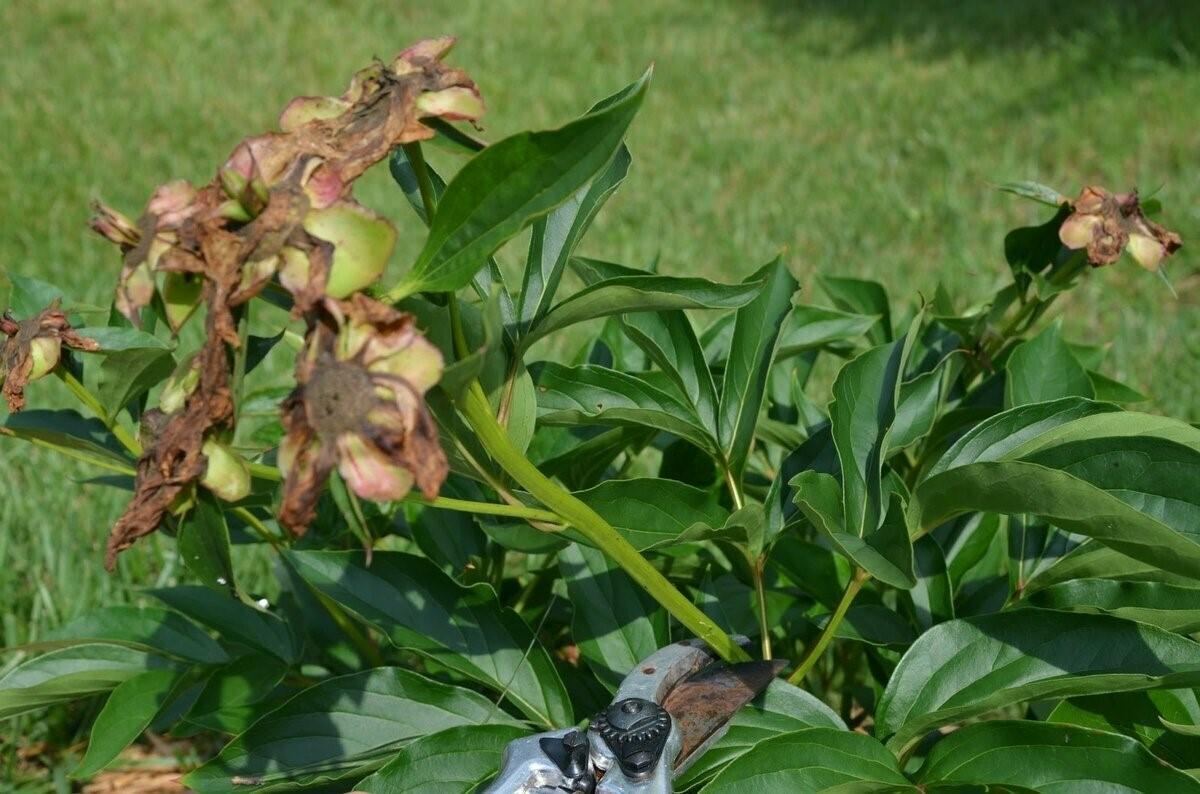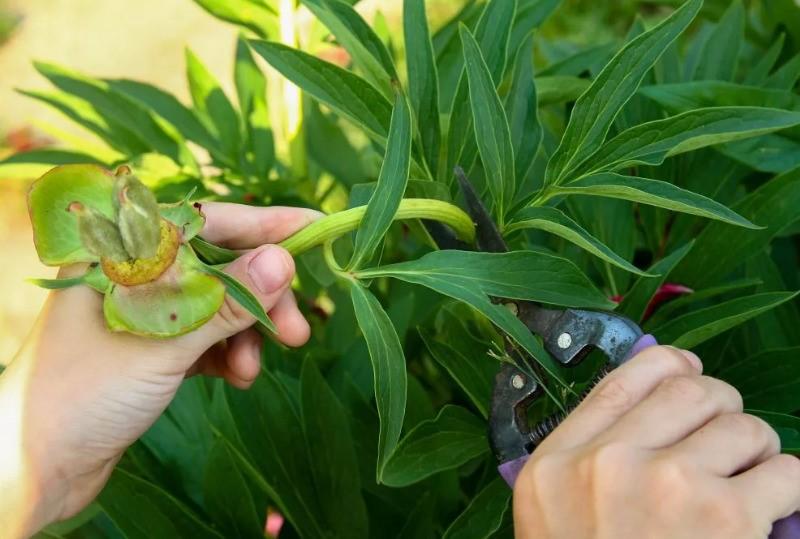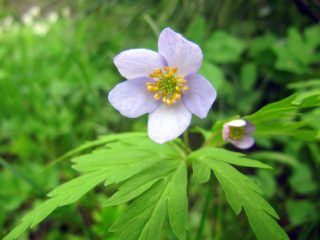Content
The peonies have faded, and the time comes when caring for them becomes especially important. These magnificent flowers, which decorate gardens with their bright colors in early summer, require attention and care after blooming. The article discusses how to properly care for peonies after flowering in summer and autumn, taking into account the peculiarities of the climate of the Moscow region.
What peonies look like after flowering
After flowering, peonies begin to change their appearance. When the flowers manage to bloom, they wither and dry up. But the stems and leaves often remain green and elastic. This means that photosynthesis continues even after flowering, and energy is accumulated through the consumption of nutrients.

After flowering, peonies remain with green leaves for a long time, maintaining their decorative appearance.
The foliage droops after the first frosts, which in the Moscow region generally begin in October. But don't worry - this is a normal process. The gardener's main focus should be on care to help the plant prepare for its next bloom and survive the winter.
Caring for peonies after flowering in the open ground
After the peonies have bloomed, the bush regains its strength, prepares for wintering, and also forms renewal buds for the next growing season. It is necessary to care for faded peonies in the open ground. After all, the beauty of the perennial next year depends on care.
Trimming
When the inflorescences have had time to bloom, it is necessary to perform the procedure of cutting off the withered peduncle. For care after flowering, you need to use sharp, disinfected pruners to prevent the bush from becoming infected.

When trimming a peduncle, it is necessary to remove only the upper part up to a large leaf.
The first step when pruning peonies after flowering is to remove the fading buds. It is necessary to cut off part of the stem with the dried inflorescence to the first full leaf. This will help the perennial focus on forming new buds and strengthening the root system instead of wasting energy on ripening seeds.
After flowering, yellowed leaves and stems, if any, should be trimmed. Check each shoot for visible damage or disease, such as spots or rot. If a damaged stem is found, cut it off from the base to prevent the spread of possible infections to the healthy part of the plant.
The time for pruning flower stalks depends on the variety; some of them have time to bloom in June, while others - in mid-summer. However, all members of the peony family require the same care after flowering.
Top dressing
Caring for peonies after flowering in July and August includes mandatory fertilization of the bush two weeks after trimming the wilted buds. During this period, the perennial requires additional nutrition to restore strength. It is important to remember that fertilizers should not be applied after August, as this can stimulate the growth of shoots that may die if frosts occur.
One of the main nutrients needed by peonies is nitrogen. It promotes the growth and development of plants, and also provides them with sufficient green mass. Feeding with nitrogen fertilizers after flowering will help peonies recover from stress and prepare for the next season.
In addition to nitrogen, peonies also need phosphorus and potassium. Phosphorus is necessary for the development of the root system and the formation of flower buds. Potassium helps strengthen plant tissues, making them more resistant to diseases and pests.
One way to feed peonies after they have bloomed is to use granular complex fertilizers that contain all the necessary nutrients. It is recommended to distribute the fertilizer evenly around the plants on the soil surface and then carefully apply it into the ground. This should be done to avoid burning out the plant roots.
Additionally, regular fertilizing with organic fertilizers such as compost or humus is a good practice to keep peonies healthy. Organic fertilizers enrich the soil with important nutrients and create a favorable environment for crop growth and development.
Watering and loosening
After peonies have bloomed, they need enough moisture to recuperate. Care consists of periodic watering.It is especially important in the hot season, when the soil can dry out. It should be remembered that peonies do not like excess moisture after flowering, so watering should be moderate and regular.
Loosening the soil is also of great importance in caring for faded peonies. It helps improve air exchange between the roots and the soil, and also improves water permeability. This is especially important after watering and heavy downpours or rains, when the soil shrinks and becomes dense. Loosening the soil should be done carefully so as not to damage the roots of the peonies. At the same time, weed removal is also carried out. Weeds interfere with growth and deprive the plant of nutrients. Therefore, care consists of periodically weeding the weeds.

Loosening can be omitted if there is a layer of mulch on the surface prepared in the spring
Transfer
In August, caring for peonies includes replanting them (after the buds have had time to bloom). Old varieties of crops can develop for a long time and bloom luxuriantly in one place without transplantation. But with new, especially hybrid varieties, this will not work. They will begin to produce small inflorescences. To avoid this, you should replant and divide the bush every 5-7 years.
In the Moscow region, this procedure can begin from the 20th of August until the end of September. They will easily tolerate it and take root well, unlike the spring transplant.

Replant plants carefully, trying not to damage the roots to minimize stress for peonies
Caring for peonies in late autumn
The buds have time to bloom in the summer, but at the end of October they carry out additional pruning. Yellowed peony leaves are cut off before snow falls or after the first frost.
It is better to cut herbaceous varieties “to zero”, exactly along the surface of the soil, without going deep, but also without leaving stumps. Ito hybrids can be pruned in two ways: “to zero” and to a stump 20 cm high. This is due to the fact that their flower buds are located not only underground, but also on the lower part of the stem, in the axils of the leaves.
One of the key points of care in the last months of autumn is covering the root zone of the plants. To do this, you can use a layer of mulch or dry leaves. Covering helps keep the roots warm and protects them from frost, which can damage the perennial.
Before winter, it is recommended to inspect the bush for diseases and pests. If any problems are found, appropriate measures are taken to prevent them from spreading. This may include removing diseased parts of the plant or using chemicals.
Recommendations from gardeners
Here are some tips from experienced gardeners for caring for peonies after flowering:
- Peonies that have already bloomed need plenty of watering. Lack of moisture can negatively affect their health and productivity. It should be remembered that peonies that have already bloomed do not like stagnant water, so you need to approach watering wisely.
- Peonies should not be replanted during budding. It is necessary to give them time so that they have time to bloom. They get along worse that way. The ideal time for this is autumn.
- Fertilizers should be applied on time. This is done after the seedlings have had time to bloom. Nutrients will ensure healthy development and strong root apparatus.
- It is necessary to properly prune bushes that have had time to bloom. It is necessary to remove dry shoots and inflorescences after flowering.This will help the peonies focus their energy on growing new shoots.
- Since peonies are perennials, they require regular division. An oversaturated bush can lead to its disease and weakening. The care rules recommend dividing it every 3-5 years. This is best done in spring or autumn, after the seedlings have had time to bloom.
Conclusion
Although the peonies have faded, caring for them continues. It is important to remember that caring for plants after flowering is not only about caring for their appearance, but also an investment in their future health and development. By following the advice of gardeners and paying attention to the needs of plants, you can preserve the beauty of peonies for many years. Proper care measures will allow the perennial to flourish year after year, delighting with its beauty and aroma.








